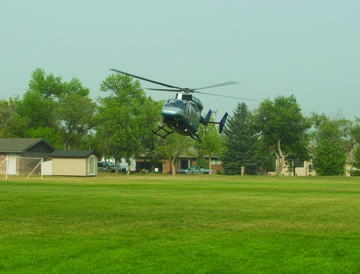Current Temperature
17.0°C
Halo 2 very close to flying the skies
Posted on August 21, 2018 by 40 Mile Commentator Commentator/Courier
HALO's BK-117.
Commentator/Courier
HALO's BK-117.Justin Seward
Commentator/Courier
Halo 2’s medievac helicoptor was officially given the green light to launch from Alberta Health Services on Aug. 15.
“Alberta Health Services have been working very well with us,” said HALO chief pilot Steve Harmer.
“They’re really putting out the stops to try and get us airborne and we’re really pleased with that. They realize there is a hole in southeast Alberta and they’re trying to plug it.
“They are on side and we’ve been given permission from them to launch. What we haven’t got is the final Is and Ts dotted. We’ve got a tiny bit of certification to do with Transport Canada.”
Paperwork is all in and a couple of oxygen ports need to be installed and in the meantime while those steps are being complete, pilot training is ongoing, he added.
Harmer flew the new four-blade, 750 horse power, BK-117 B2 helicoptor to Bow Island’s Market in the Park at Centennial Park in 12 minutes from the Medicine Hat Airport on Wednesday.
“It does two things fantastically,” said Harmer.
“One it hoists well and second it’s good for EMS. If you look in the back, you can see it’s a very flat floor. It’s not a sitting bucket like most are. We carry a real stretcher right out of an ambulance. We don’t carry a sled like the other helicopter.”
“She cruises at a 135 knots, which is 270 km an hour roughly.”
The significant difference between HALO 1 and HALO 2 is that the BK can transport a patient from the scene more efficiently to the hospital because the original helicopter struggled with the travel.
The new helicopter’s power performance is “significantly superior,” to the HALO 1 because in the summer, HALO has had to fly with a low fuel load because of the heat, he added.
Harmer did all the flight testing for the newest addition out of North Carolina and it was immense how much weight the crew had to put on board to make it fail a test.
“It was astronomical what the aircraft can do,” said Harmer.
“(It) didn’t care. I can do that in one engine no problem, which is great.”
Additionally, paramedics have more room in the back to work on the whole patient in flight as well as carry an additional patient.
The BK will have full capability in the winter whereas HALO 1 had to shut down when the sun went down at 4 p.m.
“It’s a dream come true from our standpoint down in Bow Island where we have limited resources to begin with ,” said Bow Island vascular paramedic Andrew Yaremchuk.
“(And) knowing we have this bird that we can call in from Medicine Hat and the high level of care we can call for back up, it’s a game changer.”
Leave a Reply
You must be logged in to post a comment.

